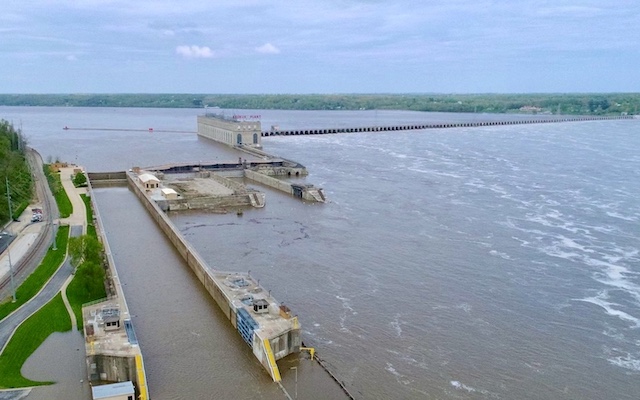
For more information about the Lock and Dam No. 19 Historic District in Keokuk visit keokukiowatourism.org.
May/June 2023 (Volume 15, Issue 3)
By Carson Ode
The genius of man over the ages has resulted in accomplishments that are mind-boggling. Men and women who are given intelligence and talents well beyond the comprehension of the average person leave the rest of us scratching our heads. “How did they do that?” Lock and Dam No. 19 Historic District, completed in 1913, falls into the “How did they do that?” scenario.
The genius behind this awesome dam, located adjacent to Keokuk on the Upper Mississippi River, was Hugh Lincoln Cooper. Born in Sheldon, Minn., Cooper began showing his genius as a 16-year-old when he undertook his first engineering project building a 40-foot bridge across a creek. The rock-and-timber structure was still serving its function 50 years later. It was the cornerstone of the career of this self-taught genius that led to assignments designing and implementing some of the world’s most complex and challenging water projects. No brick-and-mortar schools were involved, but through extensive self-study and practical field work, this was a highly educated man with a creative and practical mind.
After graduating from high school, he took on an apprenticeship with the Chicago, Milwaukee & St. Paul Railroad where his engineering skills were utilized to build bridges using material beyond rocks and timber. In 1891, Cooper became interested in hydroelectric power and left bridge building to immerse himself in learning about the construction and equipment used in harnessing water to generate electricity.
He took a position with a firm in Dayton, Ohio, that built water wheels and installed them in power plants. This was followed by constructing power plants in Jamaica, West Indies and Ellenville and Dodgeville, N.Y. The projects became more involved as he spent three years designing and building a power plant for the Sao Paulo Tramway, Light & Power Co. in Brazil.
Among the impressive commissions he took on prior to the Keokuk lock and dam was a seemingly impossible plan to harness the raging Horseshoe Rapids above Niagara Falls. He silenced the skeptical by devising a design for the Electrical Development Co. of Ontario that successfully met the objective. The construction of the power plant was completed in 1907.
In the early days of the 20th century, the Keokuk & Hamilton Water Power Co. prepared a pamphlet (prospectus) detailing some data concerning the Mississippi River and the Des Moines Rapids just above Keokuk. It was the end of the line for river traffic with water depths of only two-and-a-half feet. The priority of their aims was to raise capital and secure a competent engineer to take charge of building a dam. One of these pamphlets fell into the hands of Cooper. At this point in his life, Cooper had a worldwide reputation of taking on very complex projects from Jamaica and Brazil to Niagara Falls.
On Sept. 15, 1905, a committee in charge of the affairs of the Keokuk & Hamilton Water Power Co. entered into a contract with Cooper, by which the stock and franchise of the company were turned over to his syndicate, on the condition that the dam and power plant were to be completed by Feb. 10, 1915. Raising capital was a challenge until Stone & Webster of Boston, Mass., entered with a proposition to finance the project. Of the capital stock, 35 percent of it was raised in the United States and the remaining 65 percent came from foreign countries, predominantly England, France, Germany, Belgium and Canada.
TO READ THE ENTIRE STORY AND OTHER FASCINATING STORIES ABOUT IOWA HISTORY, subscribe to Iowa History Journal.
